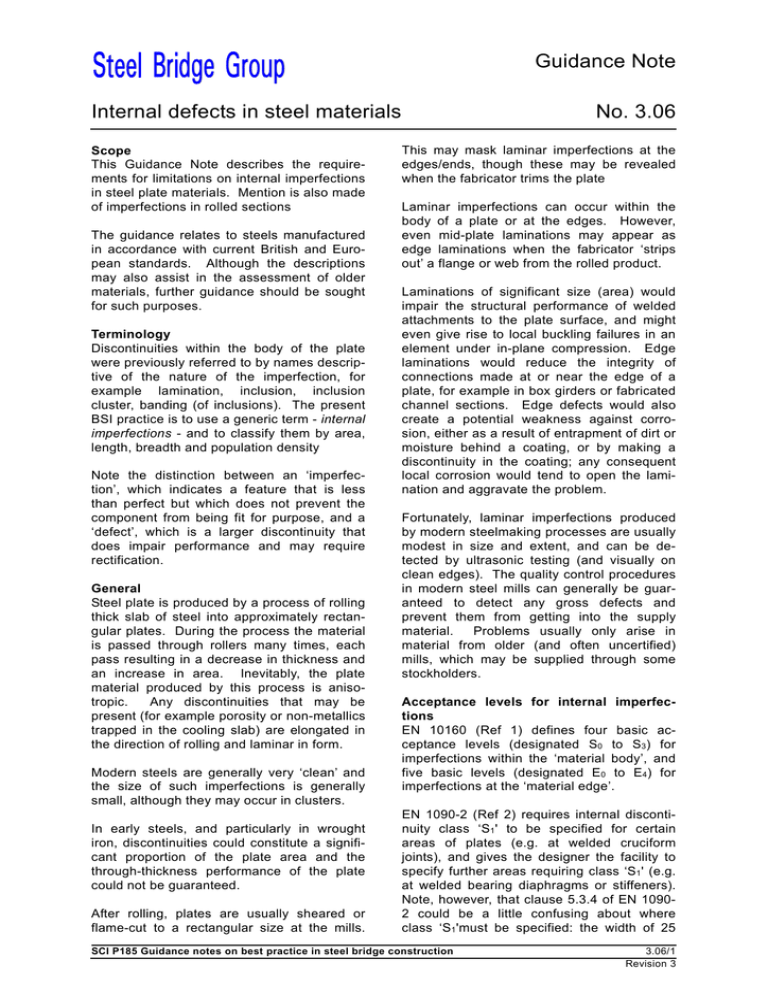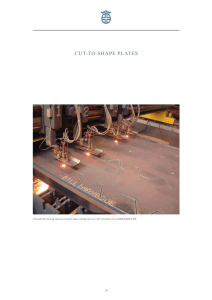Guidance Note Internal defects in steel materials No. 3.06
advertisement

Guidance Note Internal defects in steel materials Scope This Guidance Note describes the requirements for limitations on internal imperfections in steel plate materials. Mention is also made of imperfections in rolled sections The guidance relates to steels manufactured in accordance with current British and European standards. Although the descriptions may also assist in the assessment of older materials, further guidance should be sought for such purposes. Terminology Discontinuities within the body of the plate were previously referred to by names descriptive of the nature of the imperfection, for example lamination, inclusion, inclusion cluster, banding (of inclusions). The present BSI practice is to use a generic term - internal imperfections - and to classify them by area, length, breadth and population density Note the distinction between an ‘imperfection’, which indicates a feature that is less than perfect but which does not prevent the component from being fit for purpose, and a ‘defect’, which is a larger discontinuity that does impair performance and may require rectification. General Steel plate is produced by a process of rolling thick slab of steel into approximately rectangular plates. During the process the material is passed through rollers many times, each pass resulting in a decrease in thickness and an increase in area. Inevitably, the plate material produced by this process is anisotropic. Any discontinuities that may be present (for example porosity or non-metallics trapped in the cooling slab) are elongated in the direction of rolling and laminar in form. Modern steels are generally very ‘clean’ and the size of such imperfections is generally small, although they may occur in clusters. In early steels, and particularly in wrought iron, discontinuities could constitute a significant proportion of the plate area and the through-thickness performance of the plate could not be guaranteed. After rolling, plates are usually sheared or flame-cut to a rectangular size at the mills. No. 3.06 This may mask laminar imperfections at the edges/ends, though these may be revealed when the fabricator trims the plate Laminar imperfections can occur within the body of a plate or at the edges. However, even mid-plate laminations may appear as edge laminations when the fabricator ‘strips out’ a flange or web from the rolled product. Laminations of significant size (area) would impair the structural performance of welded attachments to the plate surface, and might even give rise to local buckling failures in an element under in-plane compression. Edge laminations would reduce the integrity of connections made at or near the edge of a plate, for example in box girders or fabricated channel sections. Edge defects would also create a potential weakness against corrosion, either as a result of entrapment of dirt or moisture behind a coating, or by making a discontinuity in the coating; any consequent local corrosion would tend to open the lamination and aggravate the problem. Fortunately, laminar imperfections produced by modern steelmaking processes are usually modest in size and extent, and can be detected by ultrasonic testing (and visually on clean edges). The quality control procedures in modern steel mills can generally be guaranteed to detect any gross defects and prevent them from getting into the supply material. Problems usually only arise in material from older (and often uncertified) mills, which may be supplied through some stockholders. Acceptance levels for internal imperfections EN 10160 (Ref 1) defines four basic acceptance levels (designated S0 to S3) for imperfections within the ‘material body’, and five basic levels (designated E0 to E4) for imperfections at the ‘material edge’. EN 1090-2 (Ref 2) requires internal discontinuity class ‘S1' to be specified for certain areas of plates (e.g. at welded cruciform joints), and gives the designer the facility to specify further areas requiring class ‘S1' (e.g. at welded bearing diaphragms or stiffeners). Note, however, that clause 5.3.4 of EN 10902 could be a little confusing about where class ‘S1'must be specified: the width of 25 SCI P185 Guidance notes on best practice in steel bridge construction GN306R3 3.06/1 Revision 3 Guidance Note No. 3.06 times the plate thickness should only be applied to webs and flanges where bearing diaphragms or single-sided bearing stiffeners are attached. The requirement should not normally be applied at non-bearing stiffeners or diaphragms or where bearing stiffeners are attached symmetrically on both sides of the web. The SHW, Clause 1805.3.4 (Ref 3) has a further requirement that class ‘S2' should be specified for certain areas of plates (e.g. at welded cruciform joints) where the quantified service category is F71 and above. Locations where internal discontinuity class ‘S1' (or indeed class ‘S2') is required should be specified on the relevant drawings. Also, class ‘E1’ should be specified on the relevant drawings for the edges of plates where corner welds will be made on to the surface of such plates. Remedial/repair procedures If a situation arises where unacceptable defects are discovered at a stage in the work when replacement is not practicable without jeopardizing the completion programme, there are various procedures that have been used successfully in the past to overcome the problems. Note, however, that it is important that any repair conforms to the same required standards of workmanship as any other welding on the fabrication. Special attention needs to be given to the finishing and, where necessary, surface dressing, to ensure that the fatigue class of the repair is no worse than that required by the designer at that particular location. It is for this reason that no such repairs should be carried out until the formal approval of the Engineer/Designer is obtained: as is required by the Specification. Repairs to edges Shallow edge imperfections, particularly those caused by the overlapping in rolling, can be dealt with by grinding in from the edge to make a groove suitable for welding, and employing an appropriate repair procedure. Where the edge imperfection is wider, usually part of an area of de-lamination in the middle of a larger plate which has been exposed by stripping into narrower pieces, the edges can 3.06/2 GN306R3 be repaired as above and the wider area treated as below. Repairs in the middle of plates In the very unlikely event of needing to carry out a repair to the middle of a plate, the affected area can be clamped together by use of preloaded bolts or by plug welding. If such a repair is contemplated, the size and spacing of any bolts or welds must be considered carefully. Plug welding might be suggested for better appearance, although it is very difficult to completely disguise a field of plug welds. A better solution is to cut out the affected area and let in a new piece of plate, if this can be done. Testing Any weld repairs should be tested by an appropriate non-destructive testing technique. Material with through thickness properties A requirement for material with through thickness properties is a different requirement from that limiting the extent of internal imperfections. However, specifying through thickness properties in accordance with EN 10164 (Ref 4) invokes a requirement for inspection for laminar imperfections of a high sensitivity. Such inspections should identify any significant imperfections. See GN 3.02 for advice about the need for, and the means of specifying, through thickness properties. Internal defects in rolled sections Rolled sections are susceptible to similar problems but, once again, the quality controls in modern manufacturing facilities should prevent unacceptable material reaching the market. When dealing with older sections, or with products from less well controlled mills (such as might be supplied by a stockholder), there are sometimes inclusions in the corner of an angle or channel or at the web-to-flange junction of a beam or Tee. Except in very thin sections this would seldom be a structural or durability problem, but might need to be dealt with where a gusset or cleat is attached near the corner (angle/channel) or in the middle of the flange (beam/Tee). © 2015 The Steel Construction Institute Guidance Note No. 3.06 Safety note The area of attachment of lifting lugs should always be checked for sub-surface defects, whether the material is plate or a section. References 1. EN 10160: 1999, Ultrasonic testing of steel flat plate product of thickness equal to or greater than 6 mm (reflection method). 2. EN 1090-2: 2008+A1:2011, Execution of steel structures and aluminium structures Part 2: Technical requirements for steel structures. 3. Manual of Contract Documents for Highway Works (MCHW). Volume 1: Specification for Highway Works. Series 1800 Structural Steelwork. August 2014, TSO. 4. EN 10164: 2004, Steel products with improved deformation properties perpendicular to the surface of the product. Technical delivery conditions. SCI P185 Guidance notes on best practice in steel bridge construction GN306R3 3.06/3 Revision 3




